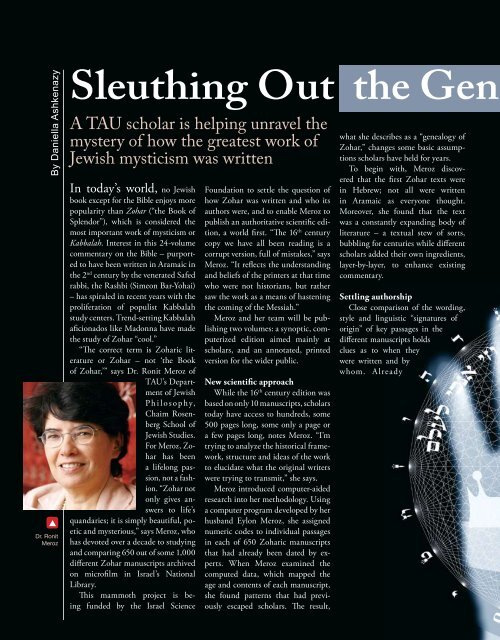Winter 2007/08
Winter 2007/08
Winter 2007/08
You also want an ePaper? Increase the reach of your titles
YUMPU automatically turns print PDFs into web optimized ePapers that Google loves.
By Daniella Ashkenazy<br />
Dr. Ronit<br />
Meroz<br />
Sleuthing Out the Gen<br />
A TAU scholar is helping unravel the<br />
mystery of how the greatest work of<br />
Jewish mysticism was written<br />
In today’s world, no Jewish<br />
book except for the Bible enjoys more<br />
popularity than Zohar (“the Book of<br />
Splendor”), which is considered the<br />
most important work of mysticism or<br />
Kabbalah. Interest in this 24-volume<br />
commentary on the Bible – purported<br />
to have been written in Aramaic in<br />
the 2 nd century by the venerated Safed<br />
rabbi, the Rashbi (Simeon Bar-Yohai)<br />
– has spiraled in recent years with the<br />
proliferation of populist Kabbalah<br />
study centers. Trend-setting Kabbalah<br />
aficionados like Madonna have made<br />
the study of Zohar “cool.”<br />
“The correct term is Zoharic literature<br />
or Zohar – not ‘the Book<br />
of Zohar,’” says Dr. Ronit Meroz of<br />
TAU’s Department<br />
of Jewish<br />
Ph i losophy,<br />
Chaim Rosenberg<br />
School of<br />
Jewish Studies.<br />
For Meroz, Zohar<br />
has been<br />
a lifelong passion,<br />
not a fashion.<br />
“Zohar not<br />
only gives answers<br />
to life’s<br />
quandaries; it is simply beautiful, poetic<br />
and mysterious,” says Meroz, who<br />
has devoted over a decade to studying<br />
and comparing 650 out of some 1,000<br />
different Zohar manuscripts archived<br />
on microfilm in Israel’s National<br />
Library.<br />
This mammoth project is being<br />
funded by the Israel Science<br />
Foundation to settle the question of<br />
how Zohar was written and who its<br />
authors were, and to enable Meroz to<br />
publish an authoritative scientific edition,<br />
a world first. “The 16 th century<br />
copy we have all been reading is a<br />
corrupt version, full of mistakes,” says<br />
Meroz. “It reflects the understanding<br />
and beliefs of the printers at that time<br />
who were not historians, but rather<br />
saw the work as a means of hastening<br />
the coming of the Messiah.”<br />
Meroz and her team will be publishing<br />
two volumes: a synoptic, computerized<br />
edition aimed mainly at<br />
scholars, and an annotated, printed<br />
version for the wider public.<br />
New scientific approach<br />
While the 16 th century edition was<br />
based on only 10 manuscripts, scholars<br />
today have access to hundreds, some<br />
500 pages long, some only a page or<br />
a few pages long, notes Meroz. “I’m<br />
trying to analyze the historical framework,<br />
structure and ideas of the work<br />
to elucidate what the original writers<br />
were trying to transmit,” she says.<br />
Meroz introduced computer-aided<br />
research into her methodology. Using<br />
a computer program developed by her<br />
husband Eylon Meroz, she assigned<br />
numeric codes to individual passages<br />
in each of 650 Zoharic manuscripts<br />
that had already been dated by experts.<br />
When Meroz examined the<br />
computed data, which mapped the<br />
age and contents of each manuscript,<br />
she found patterns that had previously<br />
escaped scholars. The result,<br />
what she describes as a “genealogy of<br />
Zohar,” changes some basic assumptions<br />
scholars have held for years.<br />
To begin with, Meroz discovered<br />
that the first Zohar texts were<br />
in Hebrew; not all were written<br />
in Aramaic as everyone thought.<br />
Moreover, she found that the text<br />
was a constantly expanding body of<br />
literature – a textual stew of sorts,<br />
bubbling for centuries while different<br />
scholars added their own ingredients,<br />
layer-by-layer, to enhance existing<br />
commentary.<br />
Settling authorship<br />
Close comparison of the wording,<br />
style and linguistic “signatures of<br />
origin” of key passages in the<br />
different manuscripts holds<br />
clues as to when they<br />
were written and by<br />
whom. A lready
















